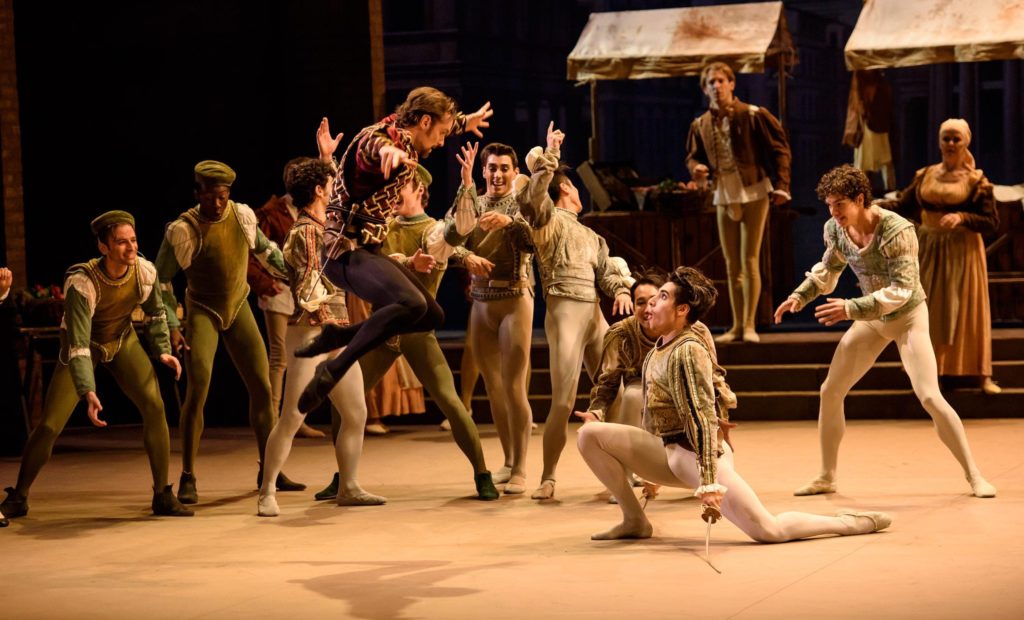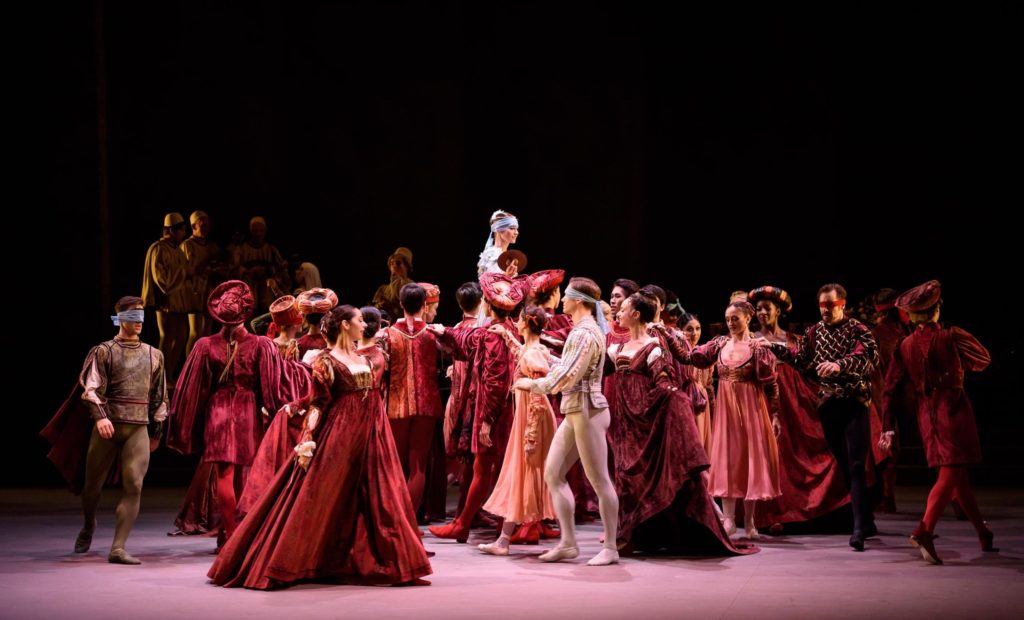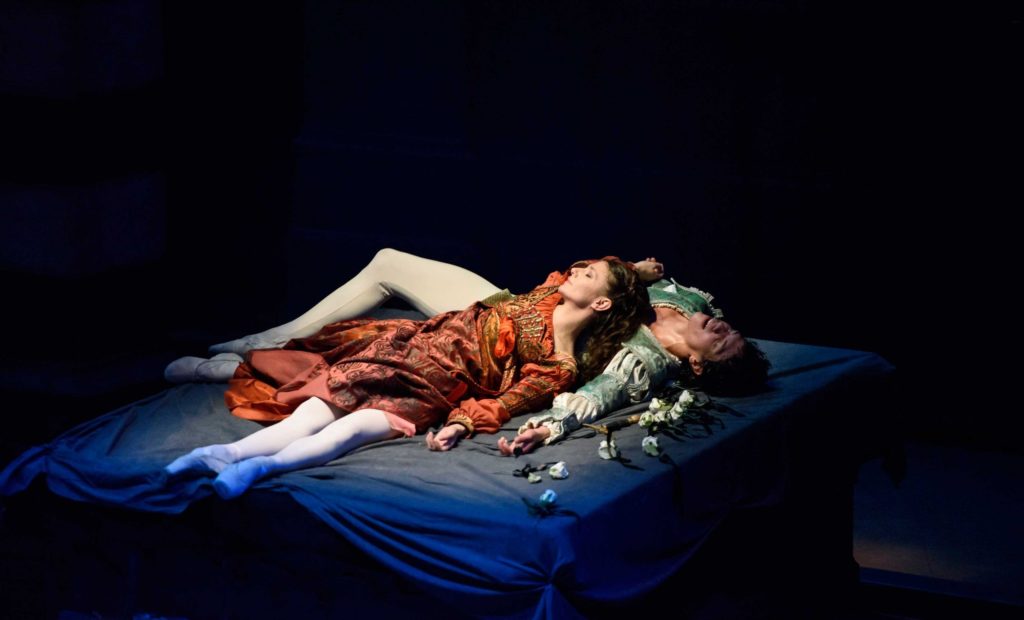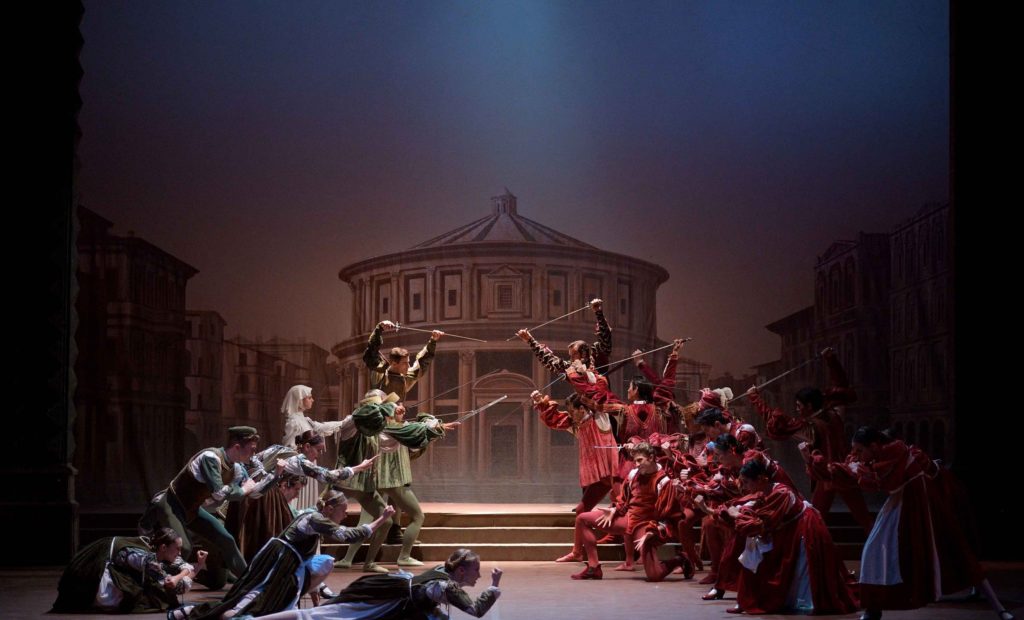STAAR Spark Reviews
A Socially-Distanced Romeo and Juliet Ballet at Sadler’s Wells
Andreea Scridon, MSt. in Creative Writing
——————————–
Published: 21 June 2020
Review process: Editorial Review
Rudolf Nureyev is perhaps a name more familiar to an older generation (due to his untimely death from AIDS in 1992) or to ballet connoisseurs exclusively. But the dancer and choreographer, who has recently come back into the spotlight with Ralph Fiennes’ 2018 biopic The White Crow, was one of the world’s most famous ballet dancers a few decades ago. A legend of magnetism and vision, Nureyev repeatedly sparked outrage for always insisting on dancing and interpreting in his own way, often making radical, modernizing changes to classical ballet. In 1977, after a history of playing Romeo himself, Nureyev turned out his own production of Romeo and Juliet, set to Sergei Prokofiev’s 1935 score, which premiered at the London Coliseum and has remained in the repertoire of the English National Ballet to this day.
Now, the successful dancer, choreographer, and director Johann Kobborg has re-adapted this production. In light of the current Covid-19 pandemic, the full show was available from May 6th to May 8th, 2020, on the YouTube channel of the English National Ballet. This consideration of the show’s online premiere seeks to document the unprecedented experience of watching a ballet performance online, and how the future of ballet might look in a post-pandemic world.
The Show Itself
Nureyev may be one of a kind, but his version proves quite contested: critics in recent years have suggested that Rudolf Nureyev’s direction of Romeo and Juliet is ‘unconvincing’ (Crisp, 2017) and ‘neurotic’ (Jennings, 2011). Though it may be less daring than Alexander Ekman’s famously innovative Eskapist (2020), I for one, as a long-time lover of all that pertains to ballet but by no means an expert in the field, found it an intriguing interpretation the original text, highlighting certain aspects in a way that has not previously explored. In many ways Nureyev’s Romeo and Juliet is experimental, or rather more representational than originally expected: bawdy, foamy, and intense.

Photo by Bill Cooper.
It might seem unorthodox at first glance to mute Shakespeare entirely: there is absolutely no audible speech in this ballet. But Nureyev may have struck gold. Radical silence only serves to emphasize the profoundly communicative and initiative nature of dance. The phenomenal evidence of hard work in the dancers’ movements, in their very bodies, evokes a downright biological, genetic connotation of creativity in which the human being becomes a work of art. These human spectacles convey dream states in a way that words are rarely able.
What stayed with me long after the show was Shakespeare’s understanding of how much Renaissance dancing, life and costumes mirror the spirit of cabaret. Unlike Baz Luhrmann’s 1996 film Romeo + Juliet, Nureyev’s ballet does not attempt to contemporize or provide a version of the original play, but instead presents it as a fusion of elements that highlight its modernity, emphasizing that it is a truly timeless tale. The famous Queen Mab scene, approached differently by every director and every Mercutio, is downright burlesque and rambunctious here, while the Capulet party seems to evoke the avant-garde, hyper self-aware dance scene in Yorgos Lanthimos’ 2018 film, The Favourite.

Photo by Bill Cooper.
The ‘versatile’ (Pritchard, 2020) Alina Cojocaru, Kobborg’s off-stage partner, is appropriately lithe and energetic to play a girl of Juliet’s age (the director resists the traditionally nubile casting choice – think Olivia Hussey in Franco Zeffirelli’s 1968 film adaptation), seeming to fly, flitting across the stage like a dragonfly. She is ethereal and innocent, yes, kissing Romeo en pointe (and later dies en pointe – a graceful touch), but I have never seen her have so much direct and raw agency before. Juliet’s fraught drama at Tybalt’s death is the stuff of Greek tragedy; she claws at herself, her hands fan rapidly and chaotic, she races across the stage and back again, showing the adolescent’s irrational, internal struggle between her family and the object of her infatuation. We witness fully and intensely the true drama of her short life. Isaac Hernández plays a Romeo of Classical serenity, delivering difficult steps smoothly; Pritchard is right to call his ‘lines pure and lean’ (2020). He is the ideal apollonian lover in physique and in attitude, if less absorbed in character than Cojocaru – although it becomes clear that in this version, she is the truly active agent. If he is the conventional lover, then Juliet is the spunk and dynamite, the clear focus of the production, the one character who feels horrified by the bloodshed around her. That said, Hernández is an exceptionally skilled collaborator, gaining momentum in choreographic dialogue. Hernández’s dance with the Montague men is particularly enthralling: he bullfights Tybalt, played by James Streeter, to death. One such example of on-stage collaboration is the scene of Mercutio’s death: what is a grotesque joke becomes a gripping act of horrible revelation, as everyone realizes that Mercutio, played by Cesar Corrales, is not playing any joke this time but is drawing his last breath. This foreshadows Juliet’s convincing agony upon finding that Romeo has drunk the poison at the end of the ballet. Like a swan, she throws her head back, releasing a shuddering cry, before making the decision to plunge the dagger into her heart. When it comes to secondary characters, Paris, played by Max Westwell, stands out in particular. Though arguably insipid in the original play, Paris’s domineering masculinity is expressed here by Maxwell’s physical movements. Westwell’s duck-toed walk is imperious and he almost manhandles the tiny Juliet when dancing with her at the Capulet ball; a great contrast to her tender harmony with Romeo.
 Photo by Bill Cooper.
Photo by Bill Cooper.
Of the arts, it is dance that naturally makes for the best expression of sensuality. The wedding night scene takes its time in unfolding but is the very opposite of lewd or pornographic: the symmetry of the dance emphasizes a natural, almost tantric order to the unfolding of the consummation. The religious imagery of the wedding scene is also beautiful: Romeo and Juliet go around in a circle, on their knees. Secondary dances provided comic relief (physical humor fitting the Renaissance context well), but also brought to mind the Greek chorus in moments of tragedy. For example, when Tybalt and Mercutio die, the secondary dancers freeze cinematically, hovering above the corpses, adding great drama to the scene. Set design, by Canadian-based sculptor David Umemoto, was beautiful, harmonious and unobtrusive: the contours of Verona’s buildings and stairwells are blurred in a distant, pastel-coloured sky, giving an impression of the painterly Sfumato technique. Costumes seem faithful to the time-period; indeed, it becomes apparent that Renaissance clothes, consisting of tights, puffed sleeves, and rich, jewel-toned colours, simply looked like ballet costumes. The atmosphere is naturally theatrical.
For the first half hour or so, my immediate reaction was to find the introduction slightly tedious. The slowness before the action begins, along with the fact that Prokofiev’s music here is less explosive and more of a background soundtrack, gave the production a slightly peripheral quality. Ultimately, Nureyev’s production builds tension slowly and steadily towards climax, as foreshadowed by the early figures of fate rolling dice and the funeral procession for plague victims at the beginning of the ballet.
 Photo by Bill Cooper.
Photo by Bill Cooper.
Ballet Streaming: Technology and Cinematography
Yet I was surprised to notice several choreographic slips and wrong moves, confirming the belief that the physical presence of the audience is conducive to the quality of a performance. It is only natural for this to be the case, considering the effect of adrenaline on the body. Ballet is a tight-rope-walk between sport and art, exacerbated by Nureyev’s notoriously difficult, flurried choreography. Alternatively, perhaps this only became apparent because many spectators would have been sat too far away to notice such – perhaps inevitable – mistakes in a live performance. The camerawork could have been better: the shots were often too wide and there weren’t enough close-ups for online viewers to fully enjoy the unique experience of supposedly having the best seat in the house. At other moments, we were shown the orchestra – understandable, but distracting when the action is already taking place, which occurred once or twice in the streaming. Nureyev’s Romeo and Juliet is a ballet, but it is also a film, and there should be equal respect for both mediums. In addition to wishing that I could have seen individual movements better by getting a closer view, I also would have appreciated an informative, brief documentary following the show introducing its historical context and role in dance and theatre aesthetics. In the pandemic context that has prompted these unprecedented streamed productions, opera seems to have had a better fate, particularly those productions uploaded online by the Metropolitan Opera in New York (such as the Richard Strauss opera Capriccio (1941), streamed at the same time as Nureyev’s Romeo and Juliet). One example of a very well-filmed ballet is Christopher Wheeldon’s adaptation of The Winter’s Tale (2014) at The Royal Ballet, which premiered online on May 1st, 2020.
The Future of Ballet in a Post-Pandemic World
Needless to say, this pandemic has been a terrible experience. However, the opportunity for anyone anywhere to watch ballet from the comfort of their own home represents undeniable progress for humanity. It is heartening to see that, with the global paradigmatic shift caused by Covid-19, culture has become more available to people who may otherwise not have the means, time, money or interest pre-Covid. This democratic sentiment of accessible educational advancement is one positive response to the fact that many performance venues in the UK are in a seriously dire financial situation.
I hope that this will be an opportunity for virtual communication of the arts to become the norm along with traditional live performances, and that the English National Ballet will continue streaming a program on their excellent YouTube channel in a post-pandemic context. As for the debated production itself, my verdict is favourable: the arts have intersected beautifully. Shakespeare has been understood and clearly relished by ballet masters and dancers alike.
Bibliography
Primary Material:
Ekman, A. (2020). Eskapist. [Videos for online streaming]. Royal Swedish Ballet in association with Marquee TV. [Kungliga Operan].
Fiennes, R. (2018). The White Crow. BBC Films, Magnolia Mae Films, Metalwork Pictures, Montebello Productions, Work in Progress.
Lanthimos, Y. (2018). The Favourite. Fox Searchlight Pictures, Film4, Waypoint Entertainment, Element Pictures, Scarlet Films.
Luhrmann, B. (1996). Romeo + Juliet. Bazmark Films, Estudios Churubusco Azteca S.A., Twentieth Century Fox.
Nureyev, R. (2015). Romeo and Juliet. [Video for online streaming]. Sadler’s Wells Theatre in association with English National Ballet Philharmonic. [Bristol Hippodrome].
Strauss, R. (2011). Capriccio. [Video for online streaming]. The Metropolitan Opera.
Wheeldon, C. (2014). The Winter’s Tale. [Video for online streaming]. The Royal Ballet. [Royal Opera House].
Zeffirelli, F. (1968). Romeo and Juliet. BHE Films, Verona Produzione, Dino de Laurentiis Cinematografica.
Secondary Material:
Crisp, C. “Romeo and Juliet, Royal Festival Hall”. Financial Times, 2 August 2017. https://www.ft.com/content/7f826cd4-776b-11e7-90c0-90a9d1bc9691.
Jennings, L. “Romeo and Juliet – review”. The Guardian, 9 January 2011. https://www.theguardian.com/stage/2011/jan/09/romeo-and-juliet-nureyev-review#maincontent.
Pritchard, J. “Alina Cojocaru’s Sadler’s Wells potpourri redeemed by her stellar dancing”. Seen and Heard International, 22 February, 2020. https://seenandheard-international.com/2020/02/alina-cojocarus-sadlers-wells-potpourri-redeemed-by-her-stellar-dancing/.
Pritchard, J. “Nureyev’s remarkable vision: ENB at Home’s Romeo & Juliet proved an unmissable treat”. Seen and Heard International, 7 May 2020. https://seenandheard-international.com/2020/05/nureyevs-remarkable-vision-enb-at-homes-romeo-juliet-proved-an-unmissable-treat/.
Suleman, B.M. “It is fun to be Queen sometimes”. 27 February 2019.
http://st-annes-mcr.org.uk/staar/publications/spark-reviews/suleman-2019-it-is-fun-to-be-queen-sometimes/.
Winship, L. “Alexander Ekman: Eskapist; Midsummer Night’s Dream review – audacious and unpredictable”. The Guardian, 27 April 2020. https://www.theguardian.com/stage/2020/apr/27/alexander-ekman-eskapist-midsummer-nights-dream-review-audacious#maincontent.
Photos:
Cooper, B. (2020). https://www.ballet.org.uk/onscreen/watch-party-romeo-juliet/

A Socially-Distanced Romeo and Juliet Ballet at Sadler’s Wells by Andreea Scridon is licensed under a Creative Commons Attribution 4.0 International License.
<< Back to Spark Reviews
<< Back to Publications
St Anne's Academic Review (STAAR) A Publication by St Anne's College Middle Common Room ISSN 2048-2566 (Online) ISSN 2515-6527 (Print)

